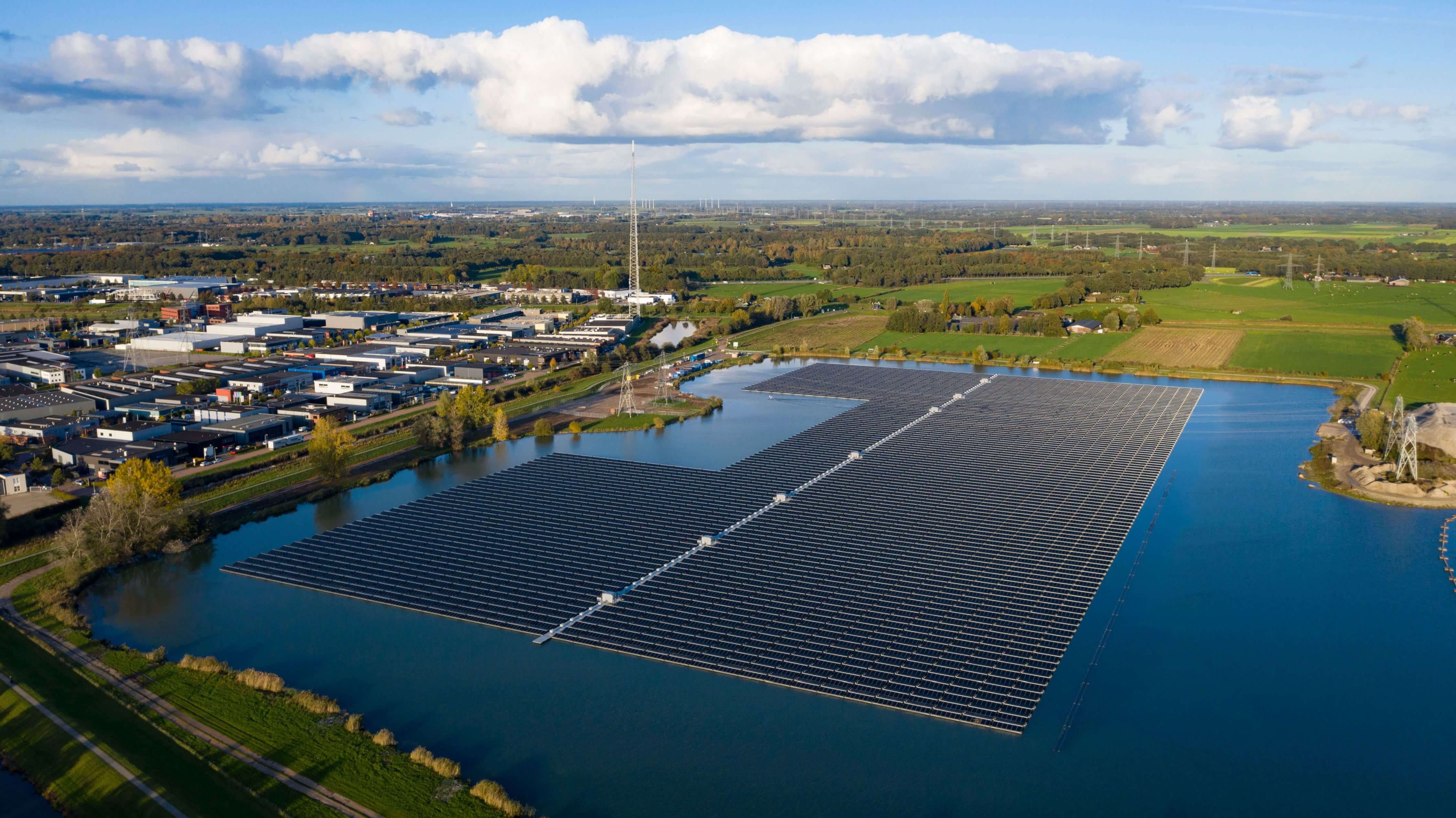Press Release #1
Fraunhofer ISE Analyzes Potential of Solar Power Plants Located on Pit Lakes in Former Lignite Mines
Commissioned by the renewable energy developer BayWa r.e., the Fraunhofer Institute of Solar Energy Systems ISE investigated the technical potential of floating photovoltaics (FPV) on pit lakes in former lignite mines in Germany. Such FPV plants that basically float on man-made lakes can help to alleviate the competition for land use and help expand PV capacity in Germany. Floating PV technology has several advantages over ground-mounted systems; for instance, greater power production due to the cooling effect of water or higher efficiency of land use. The study estimates a potential PV capacity of 56 GWp for installations on pit lakes in former lignite mines in Germany. After subtracting the estimated area use for recreational activities, tourism, nature and land conservation on pit lakes, there remains an economical potential of 2.74 GWp.

“Floating PV (FPV) power plants are a relatively new concept, which holds a large potential for electricity generation worldwide, not least because it allows a land-neutral expansion of photovoltaic capacity,” said Dr. Andreas Bett, director of Fraunhofer ISE. Depending on the scenario, estimates show that up to 500 gigawatts (GW) photovoltaic generation capacity are required for a successful energy transformation. Due to the limited amount of arable land, solutions must be developed that are less dependent on land availability. A large advantage of FPV is its higher land-use efficiency (1.33 MW/hectare). The water on which the PV array floats also provides cooling which results in somewhat higher energy yields. The PV modules and, in most cases, the inverters are installed on floating devices that are anchored either on the shore or the lake bottom. Former lignite opencast mines are also good locations for FPV since a connection to the grid already exists as a rule. If an anchoring on land is not possible, then a normal ship anchor can be used. However, this can lead to additional costs, which depend on the lake depth. The electricity generation costs for floating PV systems are about 10 to 15 percent higher than the costs for conventional ground-mounted PV power plants.
Assessing the Potential for Pit Lakes in Former Lignite Mines
About 500 pit lakes formed from lignite mining exist in Germany, covering a total area of 47,251 hectares. Most of the lakes are located in the German states of Brandenburg (29.8 %), Saxony-Anhalt (28.2%) and Saxony (15.7%). In order to assess the potential for electricity generation on these lakes, researchers interviewed public authorities, stakeholders and experts in authorization, planning, installation and water protection. A theoretically useful potential of 56 GW was originally estimated. From this value, the projected area for recreational activities, tourism, nature and land conservation was then subtracted. Pit lakes smaller than one hectare, or with large fluctuations in depth or lacking possibilities for anchorage on shore were rejected for reasons of costs. Conclusively the realistic economic potential was determined to be about 4.9 percent of the theoretical lake area, equivaling an installed power of 2.74 GWp. The largest potential is located in Lusatia and the Middle German coal district in Saxony and Saxony-Anhalt. Other types of artificial bodies of water or also natural lakes were not considered in this study, so that the total potential in Germany is probably much larger. In all, Germany has 4474 man-made lakes. Most of which were formed by surface mining for building materials. This includes 725 quarry ponds and 354 gravel lakes. The share of pit lakes from former opencast lignite mines is only 12.9 %.
In the Netherlands, the remuneration for electricity generation is sufficient to economically set up and operate floating PV systems, and BayWa r.e., a renewable energy developer, has already installed systems there. Edgar Gimbel, Head of Power Plant Engineering at BayWa r.e. Solar Project GmbH emphasizes: “We have already realized three projects with a total of 25 MWp in the Netherlands. We just began construction on Europe’s largest floating solar PV plant with 27.4 MWp. Fraunhofer ISE’s study impressively shows that there is enormous potential for floating PV in Germany. Now is the time to set up suitable boundary conditions and simplify the authorization procedures in order to make use of this potential.”
Germany’s first floating PV power plant began operation in 2019. Due to conditions laid down in the Renewable Energy Law, the nominal power was only 750 kWp.
Creating Incentives for Floating PV
Because the investment costs for floating PV are somewhat higher than ground-mounted plants, they have trouble competing in local tenders. “It would therefore make sense to have innovation tenders specifically for floating PV and other innovative PV plants that still need a market boost. In order to avoid time-consuming changes to the land use plan, the land-neutral floating PV technology should be given a privileged position, as is already the case today for the use of land for wind and nuclear power plants,” says Dr. Harry Wirth, division director of Photovoltaic Modules and Power Plants at Fraunhofer ISE. The researchers also recommend that pit lakes from former lignite opencast mines should be recognized as conversion areas under the German Renewable Energy Act. In this way, floating PV projects could participate in the call for tenders from the German Federal Network Agency. To promote the installation of FPV in pit lakes, it could be meaningful to state this use explicitly in the redevelopment framework plans for former lignite mines. To address the aspects of environmentally friendliness and public acceptance, investigations carried out on a prototype FPV plant in Germany are recommended. The project team also finds that analyzing citizen participation models, specifically addressing implementation of FPV plants, would be meaningful.
Last modified: